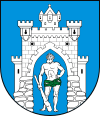Riesenburg
| Prabuty | |||
|---|---|---|---|

Cathedral in Prabuty (1st half of 14th century)
|
|||
|
|||
| Coordinates: 53°45′21″N 19°11′51″E / 53.75583°N 19.19750°ECoordinates: 53°45′21″N 19°11′51″E / 53.75583°N 19.19750°E | |||
| Country |
|
||
| Voivodeship | Pomeranian | ||
| County | Kwidzyn | ||
| Gmina | Prabuty | ||
| Town rights | 1330 | ||
| Government | |||
| • Mayor | Bogdan Józef Pawłowski | ||
| Area | |||
| • Total | 7.92 km2 (3.06 sq mi) | ||
| Elevation | 90 m (300 ft) | ||
| Population (2006) | |||
| • Total | 8,488 | ||
| • Density | 1,100/km2 (2,800/sq mi) | ||
| Time zone | CET (UTC+1) | ||
| • Summer (DST) | CEST (UTC+2) | ||
| Postal code | 82–550 | ||
| Area code(s) | +48 55 | ||
| Car plates | GKW | ||
| Website | http://www.prabuty.pl | ||
Prabuty [praˈbutɨ] (German: Riesenburg) is a town in Kwidzyn County within the Pomeranian Voivodeship of northern Poland. In the period between 1975–98 Prabuty were part of the Elbląg Voivodeship.
Prabuty is located approximately 18 kilometers east of Kwidzyn, 100 kilometers south-east of Gdańsk, 100 kilometers west of Olsztyn and 133 kilometers south-west of Kaliningrad.
Prabuty is an important rail junction on the Warszawa–Gdynia railway.
In 1236, the Teutonic Knights under Henry III, Margrave of Meissen, destroyed an Old Prussian fortress between the lakes Sorgensee (jez. Dzierzgon) and Liwieniec. The town was first mentioned in 1250 as Riesenburg. The village growing around the castle and received Culm law city rights on 30 October 1330 from bishop Rudolf of Pomesania (1322–1332).
In 1451 the town council joined the Prussian Confederation that opposed the Teutonic Order, but bishop Kaspar Linke expelled the councilors and confiscated their property. After the Battle of Chojnice, in which Polish forces were defeated, the town sided with the Order again.
After the Thirteen Years' War and the Second Peace of Thorn (1466) the town became part of Ducal Prussia although Pomesanian bishops retained their rule over the area. A synod was held in the town in 1556.
...
Wikipedia



